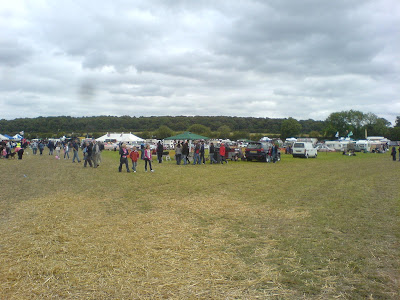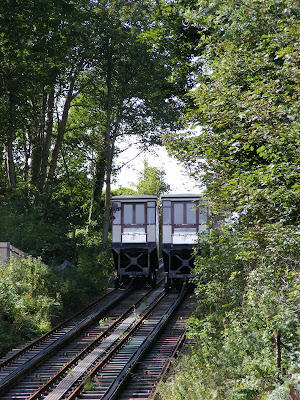 Today we visited a good friend's G Scale (45mm gauge) Garden Railway which is named "Rocky Ridge Railroad". (The regular readers amongst you will remember the post about the RRR guys visiting our garden railway back in July, and this was our return visit). The railway is based in Rugby (UK) and has been growing in both size & maturity for the last few years. Currently, the railway includes two circuits, both of which are connected to eachother at two seperate locations. Though the both line's each make a circuit of the garden, the railway 'begins' at "Balcombe North Junction" station. The station includes two platforms, a booking hall, a waiting room, a footbridge and three sidings, which also include a small engine shed. The station also allows access to both circuits as there is a cross-over just after the station. The main station building can be seen below:-
Today we visited a good friend's G Scale (45mm gauge) Garden Railway which is named "Rocky Ridge Railroad". (The regular readers amongst you will remember the post about the RRR guys visiting our garden railway back in July, and this was our return visit). The railway is based in Rugby (UK) and has been growing in both size & maturity for the last few years. Currently, the railway includes two circuits, both of which are connected to eachother at two seperate locations. Though the both line's each make a circuit of the garden, the railway 'begins' at "Balcombe North Junction" station. The station includes two platforms, a booking hall, a waiting room, a footbridge and three sidings, which also include a small engine shed. The station also allows access to both circuits as there is a cross-over just after the station. The main station building can be seen below:- Leaving "Balcombe North", the trains round a large curve before passing under a large, double-track bridge. A small intermediate station, "Rocky Ridge", which is only served by the "inner circuit" trains, is then passed on the right. Just after "Rocky Ridge", trains reach the 2nd cross-over location, allowing access to either circuit. Immediately after the cross-over the two line's part company. The "outer" line diverges upgrade to the left whilst the "inner" line diverges to the right. The "outer" lines works its way along the garden boundary on a steep climb before dropping down hill and meeting the "inner" line again. Meanwhile, the "inner" line, though climbing, meanders over gorges and a river bridge before the two line's are reunited. Just aftet the two circuits become parrallel again, the trains reach the far station, known as "Fir Tree Falls". This station is only served by the "outer" line as the "inner" track doesn't meet the platform. However, the "inner" line does include a short storage siding here. The quaint & very tranquil little station is seen below. I'm told it is named due to the massive Fir Tree which stands directly above it, forever dropping its spent foliage on the tracks!:-
Leaving "Balcombe North", the trains round a large curve before passing under a large, double-track bridge. A small intermediate station, "Rocky Ridge", which is only served by the "inner circuit" trains, is then passed on the right. Just after "Rocky Ridge", trains reach the 2nd cross-over location, allowing access to either circuit. Immediately after the cross-over the two line's part company. The "outer" line diverges upgrade to the left whilst the "inner" line diverges to the right. The "outer" lines works its way along the garden boundary on a steep climb before dropping down hill and meeting the "inner" line again. Meanwhile, the "inner" line, though climbing, meanders over gorges and a river bridge before the two line's are reunited. Just aftet the two circuits become parrallel again, the trains reach the far station, known as "Fir Tree Falls". This station is only served by the "outer" line as the "inner" track doesn't meet the platform. However, the "inner" line does include a short storage siding here. The quaint & very tranquil little station is seen below. I'm told it is named due to the massive Fir Tree which stands directly above it, forever dropping its spent foliage on the tracks!:- The three lines (including the siding) are also crossed by a level crossing at the north end of the station platform here. Leaving the station, the two tracks run parrallel for a short while before parting ways once again. The "outer" line climbs into the far tunnel whilst the "inner" line curves right and crosses another gorge via a small bridge. Emerging from the tunnel, the "outer" line heads downgrade sharply. After a straight section, trains traverse a sizeable shickane before regaining their straight path once again. They then round a left-hand curve into "Balcombe North Tunnel". When they emerge, trains have turned 90 degrees or so and are now only a few feet or so from the main station once again. Meanwhile, the "inner" line maintains a relatively straight path and, after passing over a small pond, trains arrive back at the main station from behind the engine shed, thus ends the journey of both circuits! With its considerable gradients, the line is great fun to drive on, as I found out when I was allowed to drive the resident live steam loco, "Billy". Many trains ran up & down the two circuits during the day with a popular visitor (from Derby) being this Roundhouse 'Fowler' 0-6-0 named "Becky"...
The three lines (including the siding) are also crossed by a level crossing at the north end of the station platform here. Leaving the station, the two tracks run parrallel for a short while before parting ways once again. The "outer" line climbs into the far tunnel whilst the "inner" line curves right and crosses another gorge via a small bridge. Emerging from the tunnel, the "outer" line heads downgrade sharply. After a straight section, trains traverse a sizeable shickane before regaining their straight path once again. They then round a left-hand curve into "Balcombe North Tunnel". When they emerge, trains have turned 90 degrees or so and are now only a few feet or so from the main station once again. Meanwhile, the "inner" line maintains a relatively straight path and, after passing over a small pond, trains arrive back at the main station from behind the engine shed, thus ends the journey of both circuits! With its considerable gradients, the line is great fun to drive on, as I found out when I was allowed to drive the resident live steam loco, "Billy". Many trains ran up & down the two circuits during the day with a popular visitor (from Derby) being this Roundhouse 'Fowler' 0-6-0 named "Becky"...  The Rocky Ridge Railroad runs both live steam & electric locomotives from makers such as Roundhouse, LGB, USA Trains and Bachmann as well as much varying rolling stock. However, today, it wasn't just trains that ran! The RRR also owns two live steam vehicles, a Wilesco D365 Steam Roller and a 1985 Mamod 'SW1' Steam Lorry. The two engine's were made three by my Wilesco D405 Traction Engine, visiting from our own railway of course. The three engines, especially mine, ran at regular intervals throughout the day, most notably when all three steamed together, creating much drifting steam and noisy whistling! I very much like the 'SW1'. Though simpler in design to the Wilesco engines they seen very robust and are very, very quick at building steam pressure. A very nice model kept in very good condition. The three live steamers are seen below, taking a break before the big finale. The location of the engine's was in the 'car park' of "Balcombe North Junction" Station...
The Rocky Ridge Railroad runs both live steam & electric locomotives from makers such as Roundhouse, LGB, USA Trains and Bachmann as well as much varying rolling stock. However, today, it wasn't just trains that ran! The RRR also owns two live steam vehicles, a Wilesco D365 Steam Roller and a 1985 Mamod 'SW1' Steam Lorry. The two engine's were made three by my Wilesco D405 Traction Engine, visiting from our own railway of course. The three engines, especially mine, ran at regular intervals throughout the day, most notably when all three steamed together, creating much drifting steam and noisy whistling! I very much like the 'SW1'. Though simpler in design to the Wilesco engines they seen very robust and are very, very quick at building steam pressure. A very nice model kept in very good condition. The three live steamers are seen below, taking a break before the big finale. The location of the engine's was in the 'car park' of "Balcombe North Junction" Station... Aside from locomotives and rolling stock, the RRR includes many interesting & very scenic features. One of my personal favourites are the working LGB Cable Cars which hang high above the rugged terrain close to "Rocky Ridge" station. Another favourite feature of mine is the fantastic river bridge on the "inner circuit". It looks so realistic when the trains cross over, it really does! And, finally, "Fir Tree Falls" station has to be the all time favourite. You can just imagine walking onto a station like that and waiting for a train. It is so realistic up at that end of the garden. Only the singing of the birds seems to break the silence. It is surely the perfect 'terminus' station. On top of this, one thing some people seem to overlook when they visit garden railways are the plants and flowers. The RRR have got their "plant to train ratio"(!) perfect in my opinion. The visiting Bachmann 'Circus Train', seen below, proves this as it returns from "Fir Tree Falls" on the inner line...
Aside from locomotives and rolling stock, the RRR includes many interesting & very scenic features. One of my personal favourites are the working LGB Cable Cars which hang high above the rugged terrain close to "Rocky Ridge" station. Another favourite feature of mine is the fantastic river bridge on the "inner circuit". It looks so realistic when the trains cross over, it really does! And, finally, "Fir Tree Falls" station has to be the all time favourite. You can just imagine walking onto a station like that and waiting for a train. It is so realistic up at that end of the garden. Only the singing of the birds seems to break the silence. It is surely the perfect 'terminus' station. On top of this, one thing some people seem to overlook when they visit garden railways are the plants and flowers. The RRR have got their "plant to train ratio"(!) perfect in my opinion. The visiting Bachmann 'Circus Train', seen below, proves this as it returns from "Fir Tree Falls" on the inner line... As well as the images you've seen so far, I've included the video below to further enhance your views of this fabulous garden railway...
As well as the images you've seen so far, I've included the video below to further enhance your views of this fabulous garden railway...Finally, before I end this post, we must extend a vote of thanks to everybody at Rocky Ridge Railroad. Also, thanks to those who brought along visiting stock to run for our entertainment. It truly was a very enjoyable day on at a fantastic garden railway. Thank you all. And, thank you at home for reading this post. As always, I hope you enjoyed it. More coming soon. Good Evening.
















































